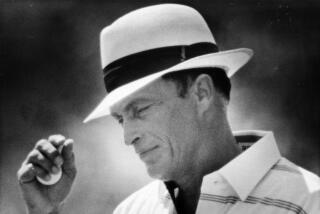Screen Star Gilbert Roland, Who Played Dashing Cisco Kid, Dies at 88
- Share via
Gilbert Roland, the lithe, muscular star whose career spanned seven decades from silents to television and included 11 films as the legendary Cisco Kid, has died. He was 88.
Roland died Sunday of cancer at his Beverly Hills home, longtime friend Scott Harrison said Monday.
Assuming the dashing Cisco role from Duncan Renaldo after World War II, Roland starred in half of the 23 sound features about the colorful Mexican Robin Hood.
(The durable Cisco Kid character, taken from a 1904 O. Henry short story titled “The Caballero’s Way,” was also played through silents, talkies, radio and television by Warner Baxter, Cesar Romero, Renaldo and this year by Jimmy Smits.)
Known for his affability, Roland was never agreeable about racial prejudice.
“My Cisco Kid might have been a bandit, but he fought for the poor and was a civilized man in the true sense of the word,” he said.
Referring to the time he added a scene showing Cisco reading Shakespeare, Roland told The Times: “I wanted to be sure the Mexicano was not portrayed as an unwashed, uneducated, savage clown.”
Roland made more than 100 films in roles ranging from shady saloon characters to romantic leads to the heroic Cisco.
He won his greatest critical praise for his role as a matador in “The Bullfighter and the Lady “ in 1951. It was the only one of his films ever nominated for an Academy Award--for the screenplay, but it did not win.
Roland was literally born to play a matador. His father had been a bullfighter in Spain and taught his family the traditions and the skills of the sport.
During the filming of the silent “Blood and Sand,” the young Roland, with his knowledge of bullfighting, was hired to help dress Rudolf Valentino as a classic matador.
Born Luis Antonio Damaso de Alonso in Chihuahua, Mexico, Roland was the second of six children of Don Francisco and Consuelo Alonso.
The Mexican Revolutionary War forced the family to flee to Juarez when he was 6. However, when Pancho Villa’s army captured the border city that year, the Alonsos fled across the Rio Grande and settled in El Paso, where Roland learned to speak English and saw his first motion picture.
He was so captivated by the movies, he later said, that he jumped on a train and headed for Hollywood at the age of 13.
For years, Roland worked at different jobs, unloading ships on Catalina Island and unloading newspapers for Los Angeles Times dealers. The aspiring actor took any job to survive. But whenever there was a chance to get a part as a film extra, he left his job to race to the studios.
He appeared as an anonymous player in some early silent classics, beginning with “The Hunchback of Notre Dame” in 1923 with Lon Chaney. Roland earned $3 and a box lunch.
Until 1925, the best Roland could do was the second lead in “The Plastic Age.” The dapper star with what became known as the “Gilbert Roland profile” often watched the film in his later years at the Silent Movie on Fairfax Avenue.
Roland was ready to give it all up and travel to Spain to try bullfighting when Joseph M. Schenck of United Artists saw one of his films and cast him in the lead role of Armand Duval, opposite Schenck’s wife, Norma Talmadge, in “Camille.”
The young actor made one other appearance in silent films, in “The Woman Disputed,” before becoming one of the few actors whose voice made him suitable for talkies.
His sound films included “New York Nights” in 1929, “She Done Him Wrong” in 1933, “Thunder Trail” in 1937, and “The Sea Hawk” in 1940.
In 1941, Roland married film star Constance Bennett, but they divorced a few years later, some said because of the stardom she attained and he didn’t.
He served in Air Force intelligence during World War II, and after the war became the Cisco Kid of B movies.
Director John Huston cast him in 1949 in “When We Were Strangers,” and after that, offers came more frequently. He starred in “The Furies” in 1950. Then in 1951, he was cast in “The Bullfighter and the Lady,” which proved his most memorable role.
He worked often in the next 30 years portraying peasants, ranchers, bandits, adventurers and circus performers. He also married for the second time, in 1951, to Guillermina Cantu of Mexico City.
His last movie appearance was in “Barbarosa” in 1982.
Roland gained admirers in the movie industry for his humility and graciousness, as well as for his abilities as a storyteller. He wrote prolifically and had many of his short stories published by Reader’s Digest.
In addition to his wife, Guillermina, Roland is survived by two daughters from his first marriage, Lorinda and Gyl.
More to Read
Only good movies
Get the Indie Focus newsletter, Mark Olsen's weekly guide to the world of cinema.
You may occasionally receive promotional content from the Los Angeles Times.









